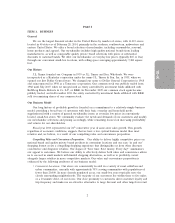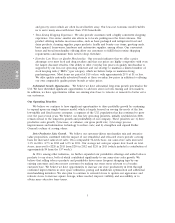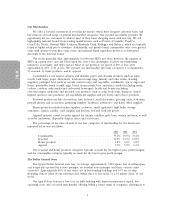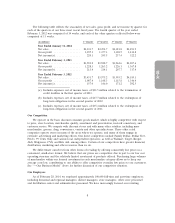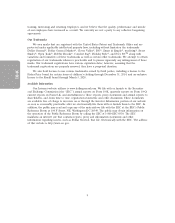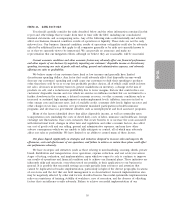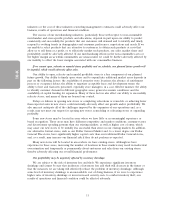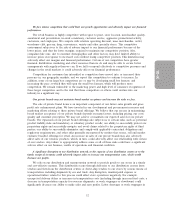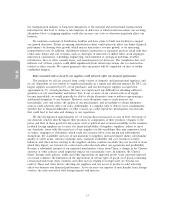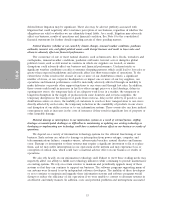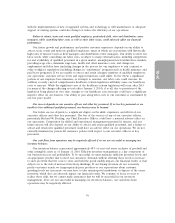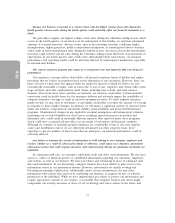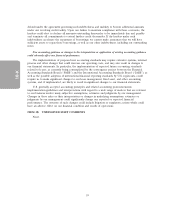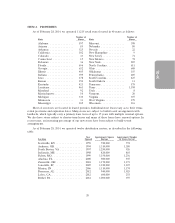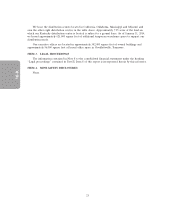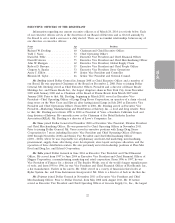Dollar General 2013 Annual Report Download - page 89
Download and view the complete annual report
Please find page 89 of the 2013 Dollar General annual report below. You can navigate through the pages in the report by either clicking on the pages listed below, or by using the keyword search tool below to find specific information within the annual report.
We face intense competition that could limit our growth opportunities and adversely impact our financial
performance.
The retail business is highly competitive with respect to price, store location, merchandise quality,
assortment and presentation, in-stock consistency, customer service, aggressive promotional activity,
customers, and employees. We compete with retailers operating discount, mass merchandise, outlet,
warehouse club, grocery, drug, convenience, variety and other specialty stores. This competitive
environment subjects us to the risk of adverse impact to our financial performance because of the
lower prices, and thus the lower margins, required to maintain our competitive position. Also,
companies like ours, due to customer demographics and other factors, may have limited ability to
increase prices in response to increased costs without losing competitive position. This limitation may
adversely affect our margins and financial performance. Certain of our competitors have greater
financial, distribution, marketing and other resources than we do and may be able to secure better
arrangements with suppliers than we can. If we fail to respond effectively to competitive pressures and
changes in the retail markets, it could adversely affect our financial performance.
Competition for customers has intensified as competitors have moved into, or increased their
presence in, our geographic markets, and we expect this competition to continue to increase. In
addition, some of our large box competitors are or may be developing small box formats, and
increasing the pace at which they will open the small box formats, which will produce more
competition. We remain vulnerable to the marketing power and high level of consumer recognition of
these larger competitors and to the risk that these competitors or others could venture into our
industry in a significant way.
Our private brands may not maintain broad market acceptance and increase the risks we face.
The sale of private brand items is an important component of our future sales growth and gross
profit rate enhancement plans. We have invested in our development and procurement resources and
marketing efforts relating to these private brand offerings. We believe that our success in maintaining
broad market acceptance of our private brands depends on many factors, including pricing, our costs,
quality and customer perception. We may not achieve or maintain our expected sales for our private
brands. The expansion of our private brand offerings also subjects us to certain risks, such as: potential
product liability risks and mandatory or voluntary product recalls; our ability to successfully protect our
proprietary rights and successfully navigate and avoid claims related to the proprietary rights of third
parties; our ability to successfully administer and comply with applicable contractual obligations and
regulatory requirements; and other risks generally encountered by entities that source, sell and market
exclusive branded offerings for retail. An increase in sales of our private brands may also adversely
affect sales of our vendors’ products, which, in turn, could adversely affect our relationship with certain
of our vendors. Any failure to appropriately address some or all of these risks could have a significant
adverse effect on our business, results of operations and financial condition.
A significant disruption to our distribution network, to the capacity of our distribution centers or to the
timely receipt of inventory could adversely impact sales or increase our transportation costs, which would
decrease our profits.
We rely on our distribution and transportation network to provide goods to our stores in a timely
and cost-effective manner. This distribution occurs through deliveries to our distribution centers from
vendors and then from the distribution centers or direct-ship vendors to our stores by various means of
transportation, including shipments by sea and truck. Any disruption, unanticipated expense or
operational failure related to this process could affect store operations negatively. For example,
unexpected delivery delays or increases in transportation costs (including through increased fuel costs, a
decrease in transportation capacity for overseas shipments, or work stoppages or slowdowns) could
significantly decrease our ability to make sales and earn profits. Labor shortages or work stoppages in
12
10-K


